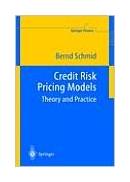|
||
podział tematyczny • wydawnictwa anglojęzyczne podział tematyczny Newsletter: • Zamów informacje o nowościach z wybranego tematu Informacje: • sposoby płatności i dostawy • kontakt • Cookies na stronie • Regulamin zakupów Napisz propresssp@gmail.com |
CREDIT RISK PRICING MODELS THEORY AND PRACTICESCHMID B.wydawnictwo: SPRINGER , rok wydania 2004, wydanie IIcena netto: The markets dealing with financial products related to credit risk have been booming over the last years. This has encouraged practitioners and academics at the same time to consider and develop sophisticated models for credit risk pricing. This book gives a deep insight into the latest basic and advanced credit risk modelling techniques covering not only the standard structural, reduced form and hybrid approaches but also showing how these methods can be applied to practice. Therefore, questions like the choice of an appropriate model, suitable parameter estimation and calibration techniques as well as back-testing issues are addressed. The book covers a broad range of financial instruments such as all kinds of defaultable fixed and floating rate debt, credit derivatives and collateralised debt obligations. In addition, there is a special emphasis on the discussion of data issues like the estimation of consistent transition matrices or the modelling of recovery rates. A lot of market data and latest credit market information completes the book. This volume will be a valuable source for the financial community involved in pricing credit linked financial instruments. In addition, the book can be used by students and academics to get a comprehensive overview of the most important credit risk modelling issues. Written for: bond portfolio optimisation collateralised debt obligations credit derivatives credit risk models Table of contents Introduction. Modelling Credit Risk Factors. Pricing Corporate and Sovereign Bonds. Correlated Defaults. Pricing Credit Derivatives. Collateralized Debt Obligations. Case Study: A Three-Factor Model for Pricing Credit Linked Financial Instruments. Some Definitions of S&P; Technical Proofs; Pricing of Credit Derivatives: Extensions. 450 pages Księgarnia nie działa. Nie odpowiadamy na pytania i nie realizujemy zamówien. Do odwolania !. |


